Janet Roberts's Blog, page 8
August 10, 2015
Cotesfield Farm - Hartington - Derbyshire
I was quite late booking this B&B, and found it on the Internet, but was immediately impressed by the emails I received from David.
It was easy to find off the A515, and I don't think we've ever received a warmer welcome. Such a nice change from impersonal chain B&B's like Travelodge!

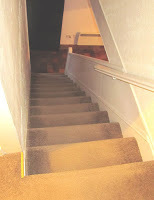
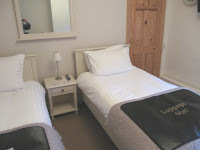
Our room was upstairs, and there was quite a steep flight of stairs, which worried me a bit, but there was a sturdy hand rail. Our room was clean and comfortable, with a good refreshment tray. The window looked directly down onto the farm yard so we could watch the swallows and house martins swoop down and into the barn - quite marvellous!
David pointed out that just beyond the farm yard was a gate that led onto the Tissington Trail, so in the evening we went for a little stroll - it was just lovely as the trail was full of the most wonderful wild flowers - an unexpected bonus.
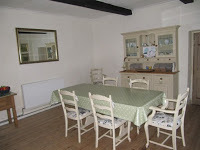 After an excellent night's sleep, not disturbed by the cockerel as we had expected, it was time for a shower and then downstairs for an amazing farmhouse breakfast. There was everything you could think of, including a lovely warm, fresh loaf of bread!
After an excellent night's sleep, not disturbed by the cockerel as we had expected, it was time for a shower and then downstairs for an amazing farmhouse breakfast. There was everything you could think of, including a lovely warm, fresh loaf of bread!
There was also a communal sitting room with books and games, ideal if it had been wet, but fortunately we didn't need it!
There were two friendly, but well-controlled dogs, and a cat. Outside we could see a lovely white horse, numerous very free-range chickens and the run for what was apparently a very large rescued rabbit.
The location of this 280 acre working farm is really good, and we will certainly be using it again.
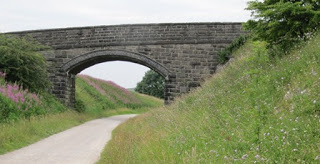
***Are you familiar with The Hardwick Love Story? For my e-book, just click here
It was easy to find off the A515, and I don't think we've ever received a warmer welcome. Such a nice change from impersonal chain B&B's like Travelodge!



Our room was upstairs, and there was quite a steep flight of stairs, which worried me a bit, but there was a sturdy hand rail. Our room was clean and comfortable, with a good refreshment tray. The window looked directly down onto the farm yard so we could watch the swallows and house martins swoop down and into the barn - quite marvellous!
David pointed out that just beyond the farm yard was a gate that led onto the Tissington Trail, so in the evening we went for a little stroll - it was just lovely as the trail was full of the most wonderful wild flowers - an unexpected bonus.
 After an excellent night's sleep, not disturbed by the cockerel as we had expected, it was time for a shower and then downstairs for an amazing farmhouse breakfast. There was everything you could think of, including a lovely warm, fresh loaf of bread!
After an excellent night's sleep, not disturbed by the cockerel as we had expected, it was time for a shower and then downstairs for an amazing farmhouse breakfast. There was everything you could think of, including a lovely warm, fresh loaf of bread!There was also a communal sitting room with books and games, ideal if it had been wet, but fortunately we didn't need it!
There were two friendly, but well-controlled dogs, and a cat. Outside we could see a lovely white horse, numerous very free-range chickens and the run for what was apparently a very large rescued rabbit.
The location of this 280 acre working farm is really good, and we will certainly be using it again.

***Are you familiar with The Hardwick Love Story? For my e-book, just click here
Published on August 10, 2015 00:55
August 5, 2015
Brightwater Gardens - Saxby - Lincolnshire
I found this lovely place through the marvellous National Gardens Scheme (see previous blog).
The garden is situated 8 miles north of Lincoln, and some 2 miles off the A15. In fact, coming from that direction it did appear to be in the middle of nowhere, with the most stunning views across open fields.
In 2000 The Garden House was built on the site of a former 1930s bungalow. This was originally owned by Annie Winifred Neave, who was an enthusiastic cottage gardener. Her great nephew Chris Neave attended Whittle College where he gained an Higher National Diploma in Amenity Horticulture Landscape Design and Recreation. He then went on to run a successful commercial landscape business for 20 years, before embarking on the creation of The Garden House.
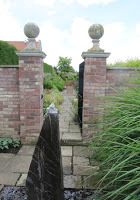 The area is divided into 'rooms', all striking different from each other, and all really stunning, particularly in mid-summer.
The area is divided into 'rooms', all striking different from each other, and all really stunning, particularly in mid-summer.
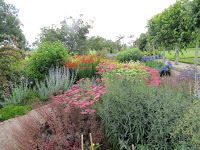 I particularly loved the massed planting - all just brimming with butterflies and bees
I particularly loved the massed planting - all just brimming with butterflies and bees
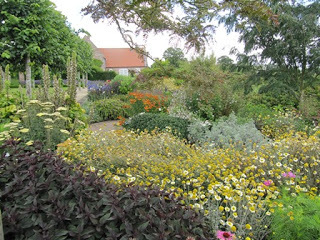
One of my favourite areas contained pleached limes - always so stunning and especially appreciated now that Chatsworth House have just removed theirs.
It was also possible to walk out beside the fields, but the multitude of flies were a bit of a problem. Probably better at another time of the year!
Then it was time for something to eat, and there is a very nice barn conversion, although I must admit I was rather disappointed with the food! I had gone mid-morning as the Gardens open at 11am, and really fancied something savoury, like a cheese scone or, even better, a salad cob, but there were only cakes on offer. Victoria sponge at mid-day just doesn't hit the spot!
However, on enquiring it was good to know that this lovely space is sometimes used by the village for things like Harvest Festivals etc. There is also a connection with the Brightwater Green Burial Meadow which is on land that has been farmed by the family for 130 years - what a lovely place to spend eternity!
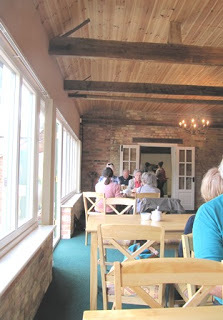
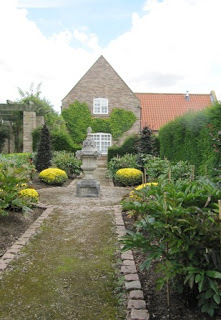
I really enjoyed visiting this special place, even if they don't sell plants, and I came away hungry! It has the most lovely atmosphere, and they are certainly doing their bit for wildlife judging from all the bees about.
It would be nice to visit again when the snowdrops, crocus, narcissi and bluebell are in flower.
***Are you familiar with The Elvaston Love Story? Just click here
The garden is situated 8 miles north of Lincoln, and some 2 miles off the A15. In fact, coming from that direction it did appear to be in the middle of nowhere, with the most stunning views across open fields.
In 2000 The Garden House was built on the site of a former 1930s bungalow. This was originally owned by Annie Winifred Neave, who was an enthusiastic cottage gardener. Her great nephew Chris Neave attended Whittle College where he gained an Higher National Diploma in Amenity Horticulture Landscape Design and Recreation. He then went on to run a successful commercial landscape business for 20 years, before embarking on the creation of The Garden House.
 The area is divided into 'rooms', all striking different from each other, and all really stunning, particularly in mid-summer.
The area is divided into 'rooms', all striking different from each other, and all really stunning, particularly in mid-summer. I particularly loved the massed planting - all just brimming with butterflies and bees
I particularly loved the massed planting - all just brimming with butterflies and bees
One of my favourite areas contained pleached limes - always so stunning and especially appreciated now that Chatsworth House have just removed theirs.

It was also possible to walk out beside the fields, but the multitude of flies were a bit of a problem. Probably better at another time of the year!
Then it was time for something to eat, and there is a very nice barn conversion, although I must admit I was rather disappointed with the food! I had gone mid-morning as the Gardens open at 11am, and really fancied something savoury, like a cheese scone or, even better, a salad cob, but there were only cakes on offer. Victoria sponge at mid-day just doesn't hit the spot!
However, on enquiring it was good to know that this lovely space is sometimes used by the village for things like Harvest Festivals etc. There is also a connection with the Brightwater Green Burial Meadow which is on land that has been farmed by the family for 130 years - what a lovely place to spend eternity!


I really enjoyed visiting this special place, even if they don't sell plants, and I came away hungry! It has the most lovely atmosphere, and they are certainly doing their bit for wildlife judging from all the bees about.
It would be nice to visit again when the snowdrops, crocus, narcissi and bluebell are in flower.
***Are you familiar with The Elvaston Love Story? Just click here
Published on August 05, 2015 03:31
July 26, 2015
Chester Zoo 2015 - Cheshire
It was a very long time since I last visited this zoo (see previous blog)but then I saw on TV last week that they had opened a new section. Here the animals would be viewed from a boat! Now that did sound like fun and I had to see it for myself!
Getting to Chester on the train was very pleasant, but I ran into a problem almost immediately. The web page, and the notices in the train station stated quite clearly "the zoo bus link leaves Chester Station from stop S6 (opposite the station) every 12 minutes from 9.24 from Monday to Saturday." What the notice failed to state was that the somewhat surly bus driver wouldn't let you on! Apparently you had to get a ticket in advance as he didn't handle money! The only place you could buy tickets was back at the railway station, from the Travel Centre. There I discovered there was a queue, with about 20 people in front of me! Not a good start to the day!
Why on earth aren't there notices telling visitors to the zoo that this is what required, or better still designated coin machines selling these cheap tickets?
In all it took exactly an hour to get from the railway station to the zoo, not helped by the fact that this Park & Ride bus put you down a considerable way from the entrance.
However, I was determined this bad start would not spoil my day, and the overwhelmingly friendly, young staff soon lifted my spirits.
I headed immediately over to Islands. What struck me was the huge amount of fun and preparation that had gone into opening this area. Everywhere you looked were interesting items connected with going on an expedition! There was a bit of a queue but nothing to worry about, and with 14 boats moving continuously it was no problem. Again I thought the staff were quite outstanding, and it was interesting that 4 of the little boats had a special area at the rear that folded down to accommodate wheelchairs, or to make access more manageable for the less able.
Then we were off past the bird market on the jetty, whilst recorded tropical sounds filled the air! We also had a very entertaining guide, and incredibly the trips are included in the entry price, so I suppose in theory you could keep going round and round!
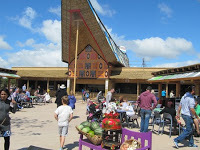 Once we'd disembarked it was time for lunch and just above the boat station was delightful Manado Street Kitchen, with the most amazing architecture. (I loved the colourful roof, made of sheets of corrugated iron!). I had vegetable Nasi Goreng, and it was absolutely lovely.
Once we'd disembarked it was time for lunch and just above the boat station was delightful Manado Street Kitchen, with the most amazing architecture. (I loved the colourful roof, made of sheets of corrugated iron!). I had vegetable Nasi Goreng, and it was absolutely lovely.
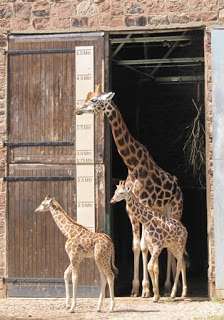 Then it was time to reluctantly leave Islands and head back into the main part of the zoo. After a ride on the monorail it was time to see the other animals, and, a sign of how happy they are at Chester Zoo I thought, babies seemed to be the order of the day.
Then it was time to reluctantly leave Islands and head back into the main part of the zoo. After a ride on the monorail it was time to see the other animals, and, a sign of how happy they are at Chester Zoo I thought, babies seemed to be the order of the day.

There was even a Pushmi-pullyu - presumably Dr. Dolittle was his keeper!
 I'd spent so much time at 'Islands' that too soon it was time to leave and think about getting back to the bus. I still hadn't seen any lions or tigers, monkeys or penguins - which was really disappointing. There's nothing for it - I shall have to go again! ***Did you know I also write e-books aimed at boys 9-12? Just click here
I'd spent so much time at 'Islands' that too soon it was time to leave and think about getting back to the bus. I still hadn't seen any lions or tigers, monkeys or penguins - which was really disappointing. There's nothing for it - I shall have to go again! ***Did you know I also write e-books aimed at boys 9-12? Just click here
Getting to Chester on the train was very pleasant, but I ran into a problem almost immediately. The web page, and the notices in the train station stated quite clearly "the zoo bus link leaves Chester Station from stop S6 (opposite the station) every 12 minutes from 9.24 from Monday to Saturday." What the notice failed to state was that the somewhat surly bus driver wouldn't let you on! Apparently you had to get a ticket in advance as he didn't handle money! The only place you could buy tickets was back at the railway station, from the Travel Centre. There I discovered there was a queue, with about 20 people in front of me! Not a good start to the day!
Why on earth aren't there notices telling visitors to the zoo that this is what required, or better still designated coin machines selling these cheap tickets?
In all it took exactly an hour to get from the railway station to the zoo, not helped by the fact that this Park & Ride bus put you down a considerable way from the entrance.
However, I was determined this bad start would not spoil my day, and the overwhelmingly friendly, young staff soon lifted my spirits.
I headed immediately over to Islands. What struck me was the huge amount of fun and preparation that had gone into opening this area. Everywhere you looked were interesting items connected with going on an expedition! There was a bit of a queue but nothing to worry about, and with 14 boats moving continuously it was no problem. Again I thought the staff were quite outstanding, and it was interesting that 4 of the little boats had a special area at the rear that folded down to accommodate wheelchairs, or to make access more manageable for the less able.
Then we were off past the bird market on the jetty, whilst recorded tropical sounds filled the air! We also had a very entertaining guide, and incredibly the trips are included in the entry price, so I suppose in theory you could keep going round and round!
 Once we'd disembarked it was time for lunch and just above the boat station was delightful Manado Street Kitchen, with the most amazing architecture. (I loved the colourful roof, made of sheets of corrugated iron!). I had vegetable Nasi Goreng, and it was absolutely lovely.
Once we'd disembarked it was time for lunch and just above the boat station was delightful Manado Street Kitchen, with the most amazing architecture. (I loved the colourful roof, made of sheets of corrugated iron!). I had vegetable Nasi Goreng, and it was absolutely lovely. Then it was time to reluctantly leave Islands and head back into the main part of the zoo. After a ride on the monorail it was time to see the other animals, and, a sign of how happy they are at Chester Zoo I thought, babies seemed to be the order of the day.
Then it was time to reluctantly leave Islands and head back into the main part of the zoo. After a ride on the monorail it was time to see the other animals, and, a sign of how happy they are at Chester Zoo I thought, babies seemed to be the order of the day.
There was even a Pushmi-pullyu - presumably Dr. Dolittle was his keeper!
 I'd spent so much time at 'Islands' that too soon it was time to leave and think about getting back to the bus. I still hadn't seen any lions or tigers, monkeys or penguins - which was really disappointing. There's nothing for it - I shall have to go again! ***Did you know I also write e-books aimed at boys 9-12? Just click here
I'd spent so much time at 'Islands' that too soon it was time to leave and think about getting back to the bus. I still hadn't seen any lions or tigers, monkeys or penguins - which was really disappointing. There's nothing for it - I shall have to go again! ***Did you know I also write e-books aimed at boys 9-12? Just click here
Published on July 26, 2015 11:49
July 11, 2015
Library in a telephone box - Hoveringham - Nottinghamshire
Hoveringham is a small village about 10 miles north east of Nottingham. I went there recently for an event organised by the marvellous Lowdham Book Festival (see previous blog).
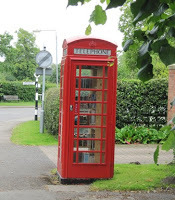 Near the village hall stood a red phone box - nothing unusual about that, except that I'd been told it was actually a library - so this I had to see!
Near the village hall stood a red phone box - nothing unusual about that, except that I'd been told it was actually a library - so this I had to see!
The history is that in 2002 there were 92,000 BT phone boxes on the streets of Britain. But times change, and as more and more people acquired, and relied on, mobile phones, the need for public phones fell out of fashion. During the last 20 years the company has stripped thousands of boxes from their locations, and presumably crushed them to death!
But for many towns and villages the phone box is part of the community's history - they are landmarks and an important part of the scenery and character of the village. People just didn't want an empty space were their red box had once stood.
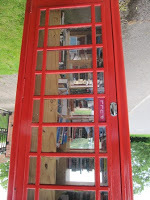 So after a bit of an outcry BT launched a programmed called 'Adopt a kiosk' in 2009. This allowed local communities and parish councils to adopt decommissioned telephone boxes in their areas for as little as one pound, and then they could turn them into something else. What a brilliant idea!
So after a bit of an outcry BT launched a programmed called 'Adopt a kiosk' in 2009. This allowed local communities and parish councils to adopt decommissioned telephone boxes in their areas for as little as one pound, and then they could turn them into something else. What a brilliant idea!
Since 2009 over 1,500 have had their phones removed by BT, and, according to the web,they have been adopted and converted into art galleries, tea rooms (!), florists, grocery shops and lending libraries.
The one at Hoveringham certainly appeared to be unlocked, and although I couldn't see a sign, I think it worked on the principle of 'take a book out, replace it with another one', an idea I first came across whilst staying at Findhorn (see previous blog.)

BT now says: 'The most fantastic thing about the Adopt A Kiosk scheme has been how communities across the country have become involved. Red phone boxes have become a focal point for all sorts of activities of real value to the local community. It's so gratifying to see our old rarely used boxes given a new lease of life."
Recycling at it's best I'd say.
***Are you familiar with The Clumber Love Story? For my e-book just click here
 Near the village hall stood a red phone box - nothing unusual about that, except that I'd been told it was actually a library - so this I had to see!
Near the village hall stood a red phone box - nothing unusual about that, except that I'd been told it was actually a library - so this I had to see!The history is that in 2002 there were 92,000 BT phone boxes on the streets of Britain. But times change, and as more and more people acquired, and relied on, mobile phones, the need for public phones fell out of fashion. During the last 20 years the company has stripped thousands of boxes from their locations, and presumably crushed them to death!
But for many towns and villages the phone box is part of the community's history - they are landmarks and an important part of the scenery and character of the village. People just didn't want an empty space were their red box had once stood.
 So after a bit of an outcry BT launched a programmed called 'Adopt a kiosk' in 2009. This allowed local communities and parish councils to adopt decommissioned telephone boxes in their areas for as little as one pound, and then they could turn them into something else. What a brilliant idea!
So after a bit of an outcry BT launched a programmed called 'Adopt a kiosk' in 2009. This allowed local communities and parish councils to adopt decommissioned telephone boxes in their areas for as little as one pound, and then they could turn them into something else. What a brilliant idea!Since 2009 over 1,500 have had their phones removed by BT, and, according to the web,they have been adopted and converted into art galleries, tea rooms (!), florists, grocery shops and lending libraries.
The one at Hoveringham certainly appeared to be unlocked, and although I couldn't see a sign, I think it worked on the principle of 'take a book out, replace it with another one', an idea I first came across whilst staying at Findhorn (see previous blog.)

BT now says: 'The most fantastic thing about the Adopt A Kiosk scheme has been how communities across the country have become involved. Red phone boxes have become a focal point for all sorts of activities of real value to the local community. It's so gratifying to see our old rarely used boxes given a new lease of life."
Recycling at it's best I'd say.
***Are you familiar with The Clumber Love Story? For my e-book just click here
Published on July 11, 2015 02:03
July 6, 2015
RHS Hampton Court Palace Flower Show - Surrey
I'd already been to these shows at the NEC in Birmingham and Tatton Park in Cheshire so now it was time to visit the big one at Hampton Court!
 The first thing that struck me was the vast crowds, all heading the same way! Also, what a long way it was from the bus to the show entrance. It was no comfort to then be told on arriving that there was transport available! Why weren't there signs saying this at the beginning? And surely there was a better route than everyone, including the less physically able, having to climb a vast number of steps to get over a very high bridge.
The first thing that struck me was the vast crowds, all heading the same way! Also, what a long way it was from the bus to the show entrance. It was no comfort to then be told on arriving that there was transport available! Why weren't there signs saying this at the beginning? And surely there was a better route than everyone, including the less physically able, having to climb a vast number of steps to get over a very high bridge.
Generally the complete lack of signs was a problem I found. I wanted something simple that pointed in the direction of 'The Floral Tent', the 'Show Gardens', etc. Presumable you were supposed to buy a programme, but I didn't want to have to carry one all day, and I certainly didn't want to stand and read it when I arrived!
It was the show gardens I was particularly keen to see, and I was surprised that, on enquiring, they were dotted around all over the place, and it was quite by chance that I stumbled across them. In fact it was somewhat hard to understand if there was an overall plan or it was all just random.
One thing I hadn't realised that this Show is actually on two sites, with pontoon-style bridges going over the water, which were quite fun as they bounced as the crowds surged across!

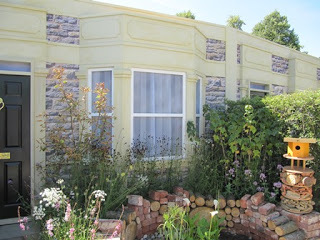
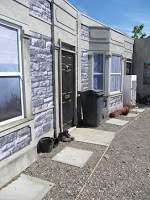 One of the gardens I quickly found was 'Community Street', which was based on a real street in Bristol. One side showed the awful grey spaces in front of the homes, and then on the other side the incredible transformation - very inspirational.
One of the gardens I quickly found was 'Community Street', which was based on a real street in Bristol. One side showed the awful grey spaces in front of the homes, and then on the other side the incredible transformation - very inspirational.
Another design I really liked, again based on a real place in south east London, was called 'Jacksons Secret Garden Party'. Visitors could walk all round the site, gazing out through the 'front windows' of each house, and the accompanying leaflet told you a little about the residents.It was fascinating to see how each resident had put their individual personality onto such a small space.
Of course no visit to a show like this would be complete without a visit to the Floral Tent, and to be greeted by this fine fellow was fun! No wonder the Academy of Floristry gained a Bronze Medal.
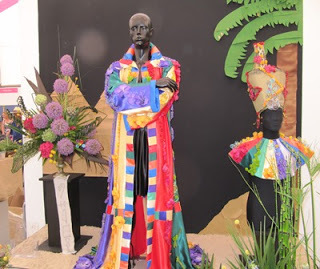 I was glad I'd had the experience of attending this Show, but the vast crowds made getting round so difficult I wont be returning in the future. Just once was enough for me!
I was glad I'd had the experience of attending this Show, but the vast crowds made getting round so difficult I wont be returning in the future. Just once was enough for me!
***Are you familiar with the romantic Elvaston Love Story? To find out more just click here
 The first thing that struck me was the vast crowds, all heading the same way! Also, what a long way it was from the bus to the show entrance. It was no comfort to then be told on arriving that there was transport available! Why weren't there signs saying this at the beginning? And surely there was a better route than everyone, including the less physically able, having to climb a vast number of steps to get over a very high bridge.
The first thing that struck me was the vast crowds, all heading the same way! Also, what a long way it was from the bus to the show entrance. It was no comfort to then be told on arriving that there was transport available! Why weren't there signs saying this at the beginning? And surely there was a better route than everyone, including the less physically able, having to climb a vast number of steps to get over a very high bridge.Generally the complete lack of signs was a problem I found. I wanted something simple that pointed in the direction of 'The Floral Tent', the 'Show Gardens', etc. Presumable you were supposed to buy a programme, but I didn't want to have to carry one all day, and I certainly didn't want to stand and read it when I arrived!
It was the show gardens I was particularly keen to see, and I was surprised that, on enquiring, they were dotted around all over the place, and it was quite by chance that I stumbled across them. In fact it was somewhat hard to understand if there was an overall plan or it was all just random.
One thing I hadn't realised that this Show is actually on two sites, with pontoon-style bridges going over the water, which were quite fun as they bounced as the crowds surged across!


 One of the gardens I quickly found was 'Community Street', which was based on a real street in Bristol. One side showed the awful grey spaces in front of the homes, and then on the other side the incredible transformation - very inspirational.
One of the gardens I quickly found was 'Community Street', which was based on a real street in Bristol. One side showed the awful grey spaces in front of the homes, and then on the other side the incredible transformation - very inspirational.Another design I really liked, again based on a real place in south east London, was called 'Jacksons Secret Garden Party'. Visitors could walk all round the site, gazing out through the 'front windows' of each house, and the accompanying leaflet told you a little about the residents.It was fascinating to see how each resident had put their individual personality onto such a small space.
Of course no visit to a show like this would be complete without a visit to the Floral Tent, and to be greeted by this fine fellow was fun! No wonder the Academy of Floristry gained a Bronze Medal.
 I was glad I'd had the experience of attending this Show, but the vast crowds made getting round so difficult I wont be returning in the future. Just once was enough for me!
I was glad I'd had the experience of attending this Show, but the vast crowds made getting round so difficult I wont be returning in the future. Just once was enough for me!***Are you familiar with the romantic Elvaston Love Story? To find out more just click here
Published on July 06, 2015 06:48
June 28, 2015
'Make Yourself Comfortable' Tour - Chatsworth - Derbyshire
I had already been to Chatsworth and enjoyed this excellent, and very unusual exhibition (see previous blog)but I felt there had to be more to it than I was experiencing, especially as the signs were so hard to read! Consequently I was delighted to discover that it was possible to go on a one-hour curator-led tour. Now that had to be something good!
The badge our young guide wore said 'Hannah Obee - Curator (Exhibitions and Special Projects) Chatsworth' and she was absolutely marvellous. She told us so much about the collaboration between the staff and the Duke and Duchess about setting up this exhibition, and it was fascinating. Of course we started in the wonderful Painted Hall with it's extraordinary swivelling, tipping chairs (see previous blog). I'd not appreciated before that this was the most perfect way to lay-back and appreciate the ceiling without straining your neck, and generally falling over!
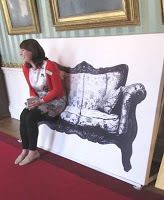 Every area we stopped in was fascinating and brought so much more to the exhibition - like this amazing Canvas Sofa created by Innermost, which I know I had walked by before thinking how odd to just have an illustration of furniture in an exhibition! In fact they were created from synthetic material on a timber frame, but could be sat on! The idea was to confuse the boundaries between contemporary seats and the historic works of art around them - and it certainly did for me!
Every area we stopped in was fascinating and brought so much more to the exhibition - like this amazing Canvas Sofa created by Innermost, which I know I had walked by before thinking how odd to just have an illustration of furniture in an exhibition! In fact they were created from synthetic material on a timber frame, but could be sat on! The idea was to confuse the boundaries between contemporary seats and the historic works of art around them - and it certainly did for me!
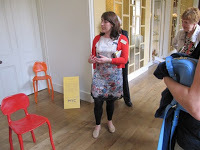 Another surprise was the Clay Dining Chairs by Maarten Baas. This was in the extraordinary ceramic gallery where Jacob van der Beugel's ceramic 'portraits' of the family, using hand-crafted ceramic blocks to represent strands from their DNA sequences, continue and combine over 300 years of ceramic collecting and family portraiture in the Devonshire Collection. What then could be more fitting in this space than synthetic clay modelled by hand round a metal skeleton then sealed with epoxy resin. They will form part of the permanent collection at Chatsworth.
Another surprise was the Clay Dining Chairs by Maarten Baas. This was in the extraordinary ceramic gallery where Jacob van der Beugel's ceramic 'portraits' of the family, using hand-crafted ceramic blocks to represent strands from their DNA sequences, continue and combine over 300 years of ceramic collecting and family portraiture in the Devonshire Collection. What then could be more fitting in this space than synthetic clay modelled by hand round a metal skeleton then sealed with epoxy resin. They will form part of the permanent collection at Chatsworth.
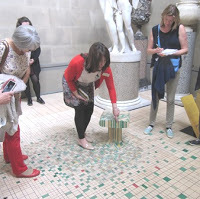 However, what really blew me away was going into the Sculpture Gallery, which I had enjoyed before, but never appreciated like now. There was so much to learn about the design and lay-out it was utterly fascinating. What I hadn't appreciated was how carefully each stool had been placed, both in relation to the sculpture but also to give the viewer a different perspective of the space.
However, what really blew me away was going into the Sculpture Gallery, which I had enjoyed before, but never appreciated like now. There was so much to learn about the design and lay-out it was utterly fascinating. What I hadn't appreciated was how carefully each stool had been placed, both in relation to the sculpture but also to give the viewer a different perspective of the space.
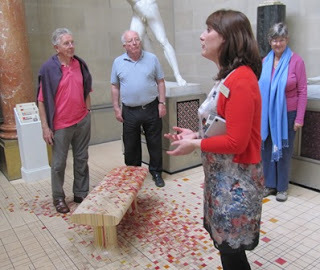 Something also I appreciated for the very first time, despite visiting Chatsworth dozens of times, was that the 6th Duke of Devonshire had gone to so much trouble in designing the sculpture bases. I know previously I had only glanced at the figures. Now I was captivated by the exquisite designs - and could have spent the rest of the afternoon studying them - but no time - we were off to the Stable Block for cream tea in a private room!
Something also I appreciated for the very first time, despite visiting Chatsworth dozens of times, was that the 6th Duke of Devonshire had gone to so much trouble in designing the sculpture bases. I know previously I had only glanced at the figures. Now I was captivated by the exquisite designs - and could have spent the rest of the afternoon studying them - but no time - we were off to the Stable Block for cream tea in a private room!
 I got so much out of this tour - and really couldn't have enjoyed it more. How much expertise, planning and thought had gone into this exhibition, over many, many months.
I got so much out of this tour - and really couldn't have enjoyed it more. How much expertise, planning and thought had gone into this exhibition, over many, many months.
Now I'm going to be on the look out for more tours with the the Chatsworth experts.
***Are you familiar with The Hardwick Love Story in this, the 400th anniversary of tragic Arbella's death? Why not take a look at my e-book
The badge our young guide wore said 'Hannah Obee - Curator (Exhibitions and Special Projects) Chatsworth' and she was absolutely marvellous. She told us so much about the collaboration between the staff and the Duke and Duchess about setting up this exhibition, and it was fascinating. Of course we started in the wonderful Painted Hall with it's extraordinary swivelling, tipping chairs (see previous blog). I'd not appreciated before that this was the most perfect way to lay-back and appreciate the ceiling without straining your neck, and generally falling over!
 Every area we stopped in was fascinating and brought so much more to the exhibition - like this amazing Canvas Sofa created by Innermost, which I know I had walked by before thinking how odd to just have an illustration of furniture in an exhibition! In fact they were created from synthetic material on a timber frame, but could be sat on! The idea was to confuse the boundaries between contemporary seats and the historic works of art around them - and it certainly did for me!
Every area we stopped in was fascinating and brought so much more to the exhibition - like this amazing Canvas Sofa created by Innermost, which I know I had walked by before thinking how odd to just have an illustration of furniture in an exhibition! In fact they were created from synthetic material on a timber frame, but could be sat on! The idea was to confuse the boundaries between contemporary seats and the historic works of art around them - and it certainly did for me! Another surprise was the Clay Dining Chairs by Maarten Baas. This was in the extraordinary ceramic gallery where Jacob van der Beugel's ceramic 'portraits' of the family, using hand-crafted ceramic blocks to represent strands from their DNA sequences, continue and combine over 300 years of ceramic collecting and family portraiture in the Devonshire Collection. What then could be more fitting in this space than synthetic clay modelled by hand round a metal skeleton then sealed with epoxy resin. They will form part of the permanent collection at Chatsworth.
Another surprise was the Clay Dining Chairs by Maarten Baas. This was in the extraordinary ceramic gallery where Jacob van der Beugel's ceramic 'portraits' of the family, using hand-crafted ceramic blocks to represent strands from their DNA sequences, continue and combine over 300 years of ceramic collecting and family portraiture in the Devonshire Collection. What then could be more fitting in this space than synthetic clay modelled by hand round a metal skeleton then sealed with epoxy resin. They will form part of the permanent collection at Chatsworth. However, what really blew me away was going into the Sculpture Gallery, which I had enjoyed before, but never appreciated like now. There was so much to learn about the design and lay-out it was utterly fascinating. What I hadn't appreciated was how carefully each stool had been placed, both in relation to the sculpture but also to give the viewer a different perspective of the space.
However, what really blew me away was going into the Sculpture Gallery, which I had enjoyed before, but never appreciated like now. There was so much to learn about the design and lay-out it was utterly fascinating. What I hadn't appreciated was how carefully each stool had been placed, both in relation to the sculpture but also to give the viewer a different perspective of the space. Something also I appreciated for the very first time, despite visiting Chatsworth dozens of times, was that the 6th Duke of Devonshire had gone to so much trouble in designing the sculpture bases. I know previously I had only glanced at the figures. Now I was captivated by the exquisite designs - and could have spent the rest of the afternoon studying them - but no time - we were off to the Stable Block for cream tea in a private room!
Something also I appreciated for the very first time, despite visiting Chatsworth dozens of times, was that the 6th Duke of Devonshire had gone to so much trouble in designing the sculpture bases. I know previously I had only glanced at the figures. Now I was captivated by the exquisite designs - and could have spent the rest of the afternoon studying them - but no time - we were off to the Stable Block for cream tea in a private room! I got so much out of this tour - and really couldn't have enjoyed it more. How much expertise, planning and thought had gone into this exhibition, over many, many months.
I got so much out of this tour - and really couldn't have enjoyed it more. How much expertise, planning and thought had gone into this exhibition, over many, many months.Now I'm going to be on the look out for more tours with the the Chatsworth experts.
***Are you familiar with The Hardwick Love Story in this, the 400th anniversary of tragic Arbella's death? Why not take a look at my e-book
Published on June 28, 2015 01:03
June 21, 2015
Hollies Farm Plant Centre - Bonsall - Derbyshire
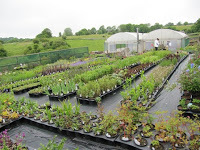 It was the wonderful National Garden Scheme yellow leaflet (see previous blog) that alerted me to this new addition to their listing.
It was the wonderful National Garden Scheme yellow leaflet (see previous blog) that alerted me to this new addition to their listing.It was certainly quite an experience winding up through the surprising large village of Bonsall, ending up nearly a thousand feet above sea level, with stunning views across Derbyshire. Immediately it was obvious that we had arrived somewhere pretty special, as a vast array of plants stretched out in front of us, on a steeply sloping bank. It claims to have the best selection of hardy perennials (including rare and unusual) in Derbyshire, and that I can well believe.
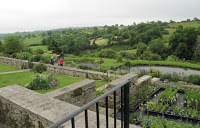 The first thing that struck me was that if a plant can survive here, it will grow in most people's gardens, as the site is high and exposed. Everywhere was spotless and highly organised and I couldn't have been more impressed. Although my photo shows rows of plants, there were in fact a lot more, with every available inch covered with clearly labelled plants. On hand was owner Robert Wells, very willing to give advice and help.
The first thing that struck me was that if a plant can survive here, it will grow in most people's gardens, as the site is high and exposed. Everywhere was spotless and highly organised and I couldn't have been more impressed. Although my photo shows rows of plants, there were in fact a lot more, with every available inch covered with clearly labelled plants. On hand was owner Robert Wells, very willing to give advice and help.I don't know if it was because it was part of the National Garden Scheme, or you could enter their private garden at other times as well, but boy was this well worth a visit. Every inch was planted, and the array of plants was staggering. Also the work involved, as hardly any part of the land was flat and easy to cultivate.
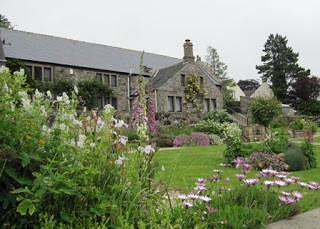
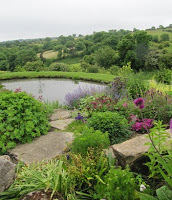 However, I was aware that it would not be suitable for anyone with mobility problems, and certainly couldn't cope with wheelchairs. However, if you're fairly able-bodied and want somewhere really special to visit, it's well worth the trip.
However, I was aware that it would not be suitable for anyone with mobility problems, and certainly couldn't cope with wheelchairs. However, if you're fairly able-bodied and want somewhere really special to visit, it's well worth the trip.I absolutely adored this place, and of course wanted everything! Eventually I settled for this box-full, whilst looking forward to my next visit!
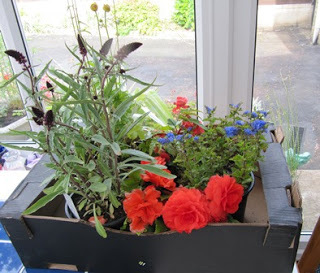 Due to being situated on the edge of the National Peak Park, they are restricted to only being open March to October, 9 am until 5pm, every day except Wednesdays, and there's no admission charge.
Due to being situated on the edge of the National Peak Park, they are restricted to only being open March to October, 9 am until 5pm, every day except Wednesdays, and there's no admission charge.***Are you familiar with the Elvaston Love Story? Just see my e-book
Published on June 21, 2015 01:40
June 8, 2015
Traquair Murals - St Peter's Church - Clayworth - Nottinghamshire
Not many people know about these amazing murals, although I had seen them many years ago on a Thoroton Tour. Now the latest newsletters from the Nottinghamshire Local History Association reminded me, and it was time to revisit.
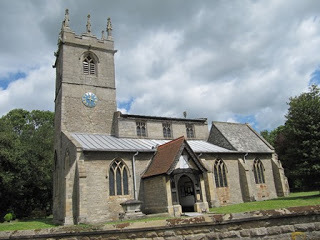 Clayworth lies along a stretch of the Roman road from Lincoln to Doncaster, with the Chesterfield Canal on the south side. The church is lovely, constructed in the 12th century. The square tower has 8 pinnacles and 8 quaint gargoyles and has some of the oldest stonework in the church, possibly dating back to an earlier Saxon building.
Clayworth lies along a stretch of the Roman road from Lincoln to Doncaster, with the Chesterfield Canal on the south side. The church is lovely, constructed in the 12th century. The square tower has 8 pinnacles and 8 quaint gargoyles and has some of the oldest stonework in the church, possibly dating back to an earlier Saxon building.
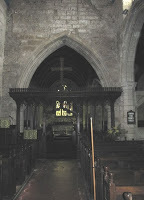 Of course, apart from the 13th century nave arches, the Norman pillars, and the many fine stained glass windows, what I wanted to see were the murals! They were completed in 1905 by renowned Scottish artist Phoebe Anna Traquair (1852 - 1936), who played a key role in the Arts and Crafts Movement. The murals are the largest work of art in the East of England and are one of only two murals in England by this artist, the rest are in Scotland.
Of course, apart from the 13th century nave arches, the Norman pillars, and the many fine stained glass windows, what I wanted to see were the murals! They were completed in 1905 by renowned Scottish artist Phoebe Anna Traquair (1852 - 1936), who played a key role in the Arts and Crafts Movement. The murals are the largest work of art in the East of England and are one of only two murals in England by this artist, the rest are in Scotland.
There was a most interesting leaflet available in the church, and inside were the actual words of Phoebe Anna Traquair describing her work:
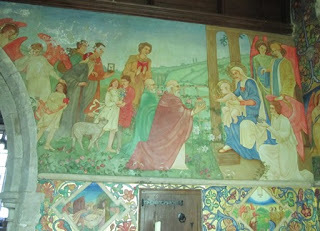 'The North side represents a group of figures bringing offerings to the Divine Child. Immediately in front kneels a figure offering incense. Behind are three children, the first two leading a lamb and carrying flowers, whilst the third brings her heart. In this group some of the children of the family of the donor have been put in. Next an old man brings his life symbolised by a time glass - almost run out, and further back a workman brings his labour (a satchel of tools on his back). Underneath in an Arabesque border on a gold background are two medallions - one representing the Entombment, and the other a symbolical combination of the Resurrection and Ascension. In the latter some of the figures are looking into the empty grave in sorrow whilst others, looking up, see the risen life. "In our troubles we should look up, not down".
'The North side represents a group of figures bringing offerings to the Divine Child. Immediately in front kneels a figure offering incense. Behind are three children, the first two leading a lamb and carrying flowers, whilst the third brings her heart. In this group some of the children of the family of the donor have been put in. Next an old man brings his life symbolised by a time glass - almost run out, and further back a workman brings his labour (a satchel of tools on his back). Underneath in an Arabesque border on a gold background are two medallions - one representing the Entombment, and the other a symbolical combination of the Resurrection and Ascension. In the latter some of the figures are looking into the empty grave in sorrow whilst others, looking up, see the risen life. "In our troubles we should look up, not down".
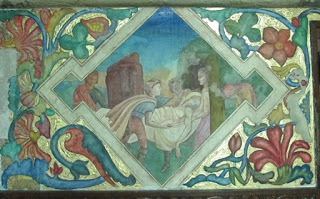
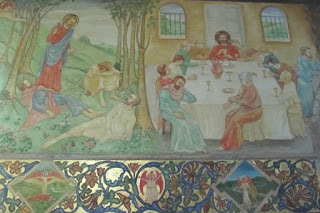
The subjects on the south wall are Christ in the Garden of Gethsemane with the sleeping disciples, the Institution of the Last Supper and the Angels."
I must admit my favourite was the painted area between two arches
"...the subject of the fresco work is a group of the Angel Choir, in which heads of some of the children of the present choir have been utilised.."
 In 1996 these murals were restored by artist Elizabeth Hirst, but I did notice that some of the paintings appeared to require further work, although this must be a very expensive undertaking. As it says in the leaflet they are a small community of 400 people (Clayworth & Wiseton) and they appreciate the donations made by visitors towards the upkeep of this lovely Grade 1 listed church - just visit www.stpeterclayworth.org
In 1996 these murals were restored by artist Elizabeth Hirst, but I did notice that some of the paintings appeared to require further work, although this must be a very expensive undertaking. As it says in the leaflet they are a small community of 400 people (Clayworth & Wiseton) and they appreciate the donations made by visitors towards the upkeep of this lovely Grade 1 listed church - just visit www.stpeterclayworth.org
This is a special place, and well worth a visit. ***Are you familiar with The Elvaston Love Story? It's the subject of my latest e-book
 Clayworth lies along a stretch of the Roman road from Lincoln to Doncaster, with the Chesterfield Canal on the south side. The church is lovely, constructed in the 12th century. The square tower has 8 pinnacles and 8 quaint gargoyles and has some of the oldest stonework in the church, possibly dating back to an earlier Saxon building.
Clayworth lies along a stretch of the Roman road from Lincoln to Doncaster, with the Chesterfield Canal on the south side. The church is lovely, constructed in the 12th century. The square tower has 8 pinnacles and 8 quaint gargoyles and has some of the oldest stonework in the church, possibly dating back to an earlier Saxon building. Of course, apart from the 13th century nave arches, the Norman pillars, and the many fine stained glass windows, what I wanted to see were the murals! They were completed in 1905 by renowned Scottish artist Phoebe Anna Traquair (1852 - 1936), who played a key role in the Arts and Crafts Movement. The murals are the largest work of art in the East of England and are one of only two murals in England by this artist, the rest are in Scotland.
Of course, apart from the 13th century nave arches, the Norman pillars, and the many fine stained glass windows, what I wanted to see were the murals! They were completed in 1905 by renowned Scottish artist Phoebe Anna Traquair (1852 - 1936), who played a key role in the Arts and Crafts Movement. The murals are the largest work of art in the East of England and are one of only two murals in England by this artist, the rest are in Scotland.There was a most interesting leaflet available in the church, and inside were the actual words of Phoebe Anna Traquair describing her work:
 'The North side represents a group of figures bringing offerings to the Divine Child. Immediately in front kneels a figure offering incense. Behind are three children, the first two leading a lamb and carrying flowers, whilst the third brings her heart. In this group some of the children of the family of the donor have been put in. Next an old man brings his life symbolised by a time glass - almost run out, and further back a workman brings his labour (a satchel of tools on his back). Underneath in an Arabesque border on a gold background are two medallions - one representing the Entombment, and the other a symbolical combination of the Resurrection and Ascension. In the latter some of the figures are looking into the empty grave in sorrow whilst others, looking up, see the risen life. "In our troubles we should look up, not down".
'The North side represents a group of figures bringing offerings to the Divine Child. Immediately in front kneels a figure offering incense. Behind are three children, the first two leading a lamb and carrying flowers, whilst the third brings her heart. In this group some of the children of the family of the donor have been put in. Next an old man brings his life symbolised by a time glass - almost run out, and further back a workman brings his labour (a satchel of tools on his back). Underneath in an Arabesque border on a gold background are two medallions - one representing the Entombment, and the other a symbolical combination of the Resurrection and Ascension. In the latter some of the figures are looking into the empty grave in sorrow whilst others, looking up, see the risen life. "In our troubles we should look up, not down".

The subjects on the south wall are Christ in the Garden of Gethsemane with the sleeping disciples, the Institution of the Last Supper and the Angels."
I must admit my favourite was the painted area between two arches
"...the subject of the fresco work is a group of the Angel Choir, in which heads of some of the children of the present choir have been utilised.."
 In 1996 these murals were restored by artist Elizabeth Hirst, but I did notice that some of the paintings appeared to require further work, although this must be a very expensive undertaking. As it says in the leaflet they are a small community of 400 people (Clayworth & Wiseton) and they appreciate the donations made by visitors towards the upkeep of this lovely Grade 1 listed church - just visit www.stpeterclayworth.org
In 1996 these murals were restored by artist Elizabeth Hirst, but I did notice that some of the paintings appeared to require further work, although this must be a very expensive undertaking. As it says in the leaflet they are a small community of 400 people (Clayworth & Wiseton) and they appreciate the donations made by visitors towards the upkeep of this lovely Grade 1 listed church - just visit www.stpeterclayworth.orgThis is a special place, and well worth a visit. ***Are you familiar with The Elvaston Love Story? It's the subject of my latest e-book
Published on June 08, 2015 01:59
May 24, 2015
'Drawn by Light' - Media Musuem - Bradford
It was the excellent reviews of this exhibition that attracted me in publications like 'The Big Issue', and as I'd never been to Bradford before, this seemed like a good excuse for a journey!
There was so much to see and do inside the magnificent Media Museum it was almost hard to take time out to visit this exhibition, which was spread over two floors, but how glad I was that I spent time there! I assumed no photography was allowed, although I saw no signs, and the illustrations here are taken from other publications. The introduction board explained that 'Drawn by Light' explores the enduring power, richness and variety of photography and showcases the work of generations of photographers.
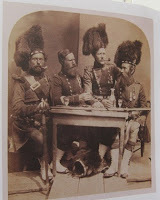 Incredibly photography was first presented to the world in 1839. By the time The Royal Photographic Society was founded, just 14 years later in 1853, the incredible versatility and potential of the medium was already apparent, and remains so over 160 years later. Even as early as the 1850s its enormous potential was already beginning to be realised and most towns had a photographer's studio and photographs were becoming everyday items rather than expensive novelties available only to a select few.
Incredibly photography was first presented to the world in 1839. By the time The Royal Photographic Society was founded, just 14 years later in 1853, the incredible versatility and potential of the medium was already apparent, and remains so over 160 years later. Even as early as the 1850s its enormous potential was already beginning to be realised and most towns had a photographer's studio and photographs were becoming everyday items rather than expensive novelties available only to a select few.
One of the many things that astounded me was the quality of these early photographs - I just couldn't believe they were so old. This very clear image of Highlanders, photographed by Joseph Cundall was taken in 1856, and how moving is this simple image by Roger Fenton taken in 1855. He had been commissioned by Queen Victoria to record events at the Crimean War, and the title, thought to have been taken from the 23rd Psalm is simply "The Valley of the Shadow of Death" showing a ravine littered with cannon balls.
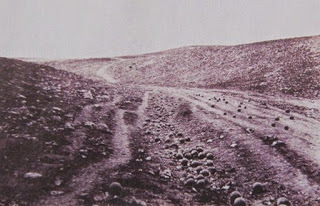
 Some of the photographs were familiar and frequently reproduced - like this striking image of Audrey Hepburn taken by Angus McBean in 1950.
Some of the photographs were familiar and frequently reproduced - like this striking image of Audrey Hepburn taken by Angus McBean in 1950.
'Portrait of Christina' taken by Lieutenant Colonel Mervyn O'Gorman amazingly was taken in 1913, and was used on the publicity material.

Of course, my favourite had to be this amazing, and very famous image of 'Afghan Girl, Pakistan' taken in a refugee camp and used on the cover of the National Geographic in 1984, which was taken by Steve Curry.

Altogether there are over 250 treasures such as this on display, and it's simply marvellous. If you possibly can, I would urge you to try and get to Bradford. I'm certainly glad I did!
****
If you would like to know more about me and my writing just click here
There was so much to see and do inside the magnificent Media Museum it was almost hard to take time out to visit this exhibition, which was spread over two floors, but how glad I was that I spent time there! I assumed no photography was allowed, although I saw no signs, and the illustrations here are taken from other publications. The introduction board explained that 'Drawn by Light' explores the enduring power, richness and variety of photography and showcases the work of generations of photographers.
 Incredibly photography was first presented to the world in 1839. By the time The Royal Photographic Society was founded, just 14 years later in 1853, the incredible versatility and potential of the medium was already apparent, and remains so over 160 years later. Even as early as the 1850s its enormous potential was already beginning to be realised and most towns had a photographer's studio and photographs were becoming everyday items rather than expensive novelties available only to a select few.
Incredibly photography was first presented to the world in 1839. By the time The Royal Photographic Society was founded, just 14 years later in 1853, the incredible versatility and potential of the medium was already apparent, and remains so over 160 years later. Even as early as the 1850s its enormous potential was already beginning to be realised and most towns had a photographer's studio and photographs were becoming everyday items rather than expensive novelties available only to a select few.One of the many things that astounded me was the quality of these early photographs - I just couldn't believe they were so old. This very clear image of Highlanders, photographed by Joseph Cundall was taken in 1856, and how moving is this simple image by Roger Fenton taken in 1855. He had been commissioned by Queen Victoria to record events at the Crimean War, and the title, thought to have been taken from the 23rd Psalm is simply "The Valley of the Shadow of Death" showing a ravine littered with cannon balls.

 Some of the photographs were familiar and frequently reproduced - like this striking image of Audrey Hepburn taken by Angus McBean in 1950.
Some of the photographs were familiar and frequently reproduced - like this striking image of Audrey Hepburn taken by Angus McBean in 1950.'Portrait of Christina' taken by Lieutenant Colonel Mervyn O'Gorman amazingly was taken in 1913, and was used on the publicity material.

Of course, my favourite had to be this amazing, and very famous image of 'Afghan Girl, Pakistan' taken in a refugee camp and used on the cover of the National Geographic in 1984, which was taken by Steve Curry.

Altogether there are over 250 treasures such as this on display, and it's simply marvellous. If you possibly can, I would urge you to try and get to Bradford. I'm certainly glad I did!
****
If you would like to know more about me and my writing just click here
Published on May 24, 2015 08:10
May 21, 2015
Woburn Abbey & Gardens - Bedfordshire
I couldn't wait to visit this impressive place, and staying at nearby Center Parcs it was just too good an opportunity to miss. (see previous blog)
 The Abbey was originally a Monastery and then in 1547 King Edward V1 gave it to the Russell family, and they've been custodians ever since. Their official title is the Duke & Duchess of Bedford.
The Abbey was originally a Monastery and then in 1547 King Edward V1 gave it to the Russell family, and they've been custodians ever since. Their official title is the Duke & Duchess of Bedford.
I was a little disappointed, but not surprised that no photography was allowed within the Abbey. It was a self-guided tour, but there were knowledgeable people in every room who were keen and enthusiastic about all the lovely furniture, tapestries and other treasures within the house. There were a number of stairs, including quite difficult spiral ones leading down to the cellar where there was a vast amount of the most impressive silver.
Then it was time to go outside into the lovely sunshine, and from a discreet distance, watch a beautiful bride and groom. I could well see why they had chosen this special place.
 The grounds are vast, and the most impressive thing was their immaculate upkeep - goodness knows how many gardeners they employ.
The grounds are vast, and the most impressive thing was their immaculate upkeep - goodness knows how many gardeners they employ.
I was particularly attracted to this unexpected area. According to the information board it was built by Henry Holland in 1787 for Francis, 5th Duke of Bedford. It was designed in what was believed to be the Chinese style, known as chinoiserie, to create an appropriate setting for the Duke's collection of Oriental porcelain. It rather reminded me of the Chinese house at Biddulph Grange - (see previous blog.)
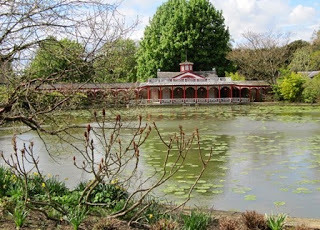 Of course no visit to Woburn would be complete without seeing the famous deer. There are 9 different species, making Woburn the largest private conservation park in Europe. I had of course glimpsed some as we arrived by taxi, but thought I would be lucky to see many on foot since the Park covers some 3,000 acres. How wrong I was! The deer were everywhere, within yards of the entrance to the Abbey, and I got some really good photos.
Of course no visit to Woburn would be complete without seeing the famous deer. There are 9 different species, making Woburn the largest private conservation park in Europe. I had of course glimpsed some as we arrived by taxi, but thought I would be lucky to see many on foot since the Park covers some 3,000 acres. How wrong I was! The deer were everywhere, within yards of the entrance to the Abbey, and I got some really good photos.
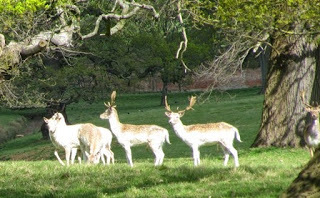
With a nice, small, personal Tea Room serving delicious cream scones, and no pushy commercial shop, this is a really nice place to visit, although allow plenty of time, as the garden and Park are just lovely.
***If you would like to know more about me and my writing just click here
 The Abbey was originally a Monastery and then in 1547 King Edward V1 gave it to the Russell family, and they've been custodians ever since. Their official title is the Duke & Duchess of Bedford.
The Abbey was originally a Monastery and then in 1547 King Edward V1 gave it to the Russell family, and they've been custodians ever since. Their official title is the Duke & Duchess of Bedford.I was a little disappointed, but not surprised that no photography was allowed within the Abbey. It was a self-guided tour, but there were knowledgeable people in every room who were keen and enthusiastic about all the lovely furniture, tapestries and other treasures within the house. There were a number of stairs, including quite difficult spiral ones leading down to the cellar where there was a vast amount of the most impressive silver.
Then it was time to go outside into the lovely sunshine, and from a discreet distance, watch a beautiful bride and groom. I could well see why they had chosen this special place.
 The grounds are vast, and the most impressive thing was their immaculate upkeep - goodness knows how many gardeners they employ.
The grounds are vast, and the most impressive thing was their immaculate upkeep - goodness knows how many gardeners they employ.I was particularly attracted to this unexpected area. According to the information board it was built by Henry Holland in 1787 for Francis, 5th Duke of Bedford. It was designed in what was believed to be the Chinese style, known as chinoiserie, to create an appropriate setting for the Duke's collection of Oriental porcelain. It rather reminded me of the Chinese house at Biddulph Grange - (see previous blog.)
 Of course no visit to Woburn would be complete without seeing the famous deer. There are 9 different species, making Woburn the largest private conservation park in Europe. I had of course glimpsed some as we arrived by taxi, but thought I would be lucky to see many on foot since the Park covers some 3,000 acres. How wrong I was! The deer were everywhere, within yards of the entrance to the Abbey, and I got some really good photos.
Of course no visit to Woburn would be complete without seeing the famous deer. There are 9 different species, making Woburn the largest private conservation park in Europe. I had of course glimpsed some as we arrived by taxi, but thought I would be lucky to see many on foot since the Park covers some 3,000 acres. How wrong I was! The deer were everywhere, within yards of the entrance to the Abbey, and I got some really good photos.
With a nice, small, personal Tea Room serving delicious cream scones, and no pushy commercial shop, this is a really nice place to visit, although allow plenty of time, as the garden and Park are just lovely.
***If you would like to know more about me and my writing just click here
Published on May 21, 2015 03:39



